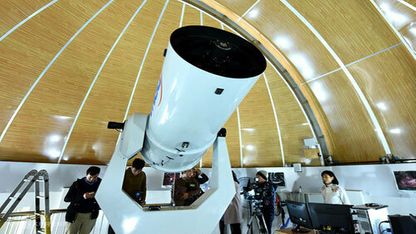Over one hundred young astro-science lovers have registered to explore the sky through telescope and the partial lunar eclipse at the Hoa Lac Astronomical Station in Hanoi on early July 17.
This is one of an array of astronomical events with the use of modern astronomy equipment to arouse and inspire students' interest in space science.
 0.5-meter telescope at Hoa Lac Astronomical Station in Hanoi. Photo: Giang Huy |
The eclipse can be seen in Central Asia, Europe, Africa and the Indian Ocean. In Vietnam, the moon will enter penumbra (the weaker part of Earth's shadow) at 1:43 am and umbra (the darker part of Earth's shadow) at 3:00 am. The midpoint of the eclipse will come at 4:30 am. The lunar eclipse will end when the moon sets at 5:28 am.
According to the organization committee, before observing the lunar eclipse, participants will watch in-house science movies about the universe and learn how to observe the planets in the solar system, constellations and other space matters in the night sky.
Lunar eclipse is an astronomical phenomenon when the moon appears darkened as it passes through the Earth's shadow.
The Hoa Lac Astronomical Station was opened in January 2019. The station has a 100-seat dome shaped theater and serves as a hub of learning for astroscience lovers, researchers and students of astronomy. It is one of the two largest space observatories in Vietnam, beside another one in Nha Trang city, Khanh Hoa province. Hanoitimes
Anh Kiet
 This is one of an array of astronomical events with the use of modern astronomy equipment to arouse and inspire students` interest in space science." itemprop="description" />
This is one of an array of astronomical events with the use of modern astronomy equipment to arouse and inspire students` interest in space science." itemprop="description" />